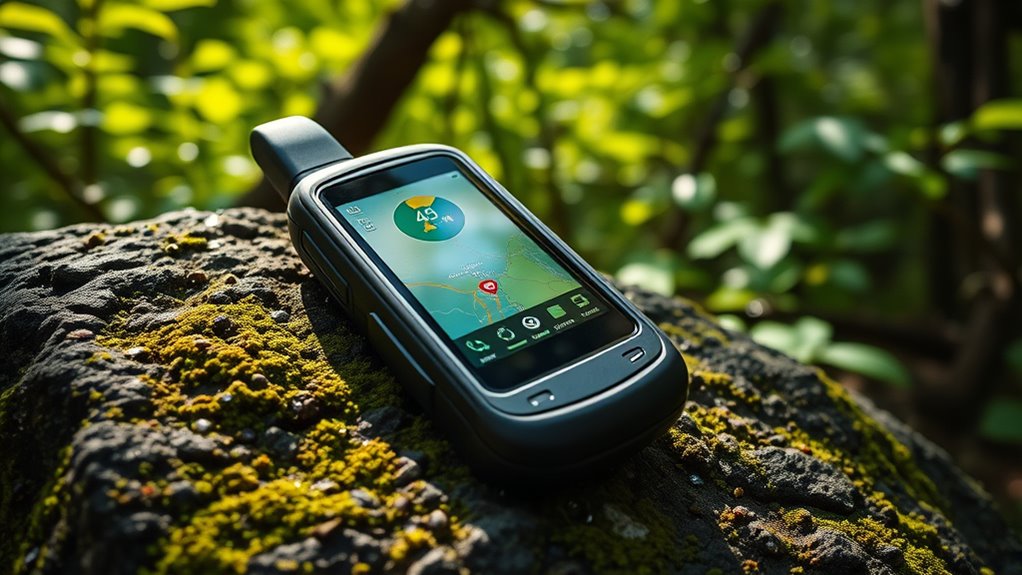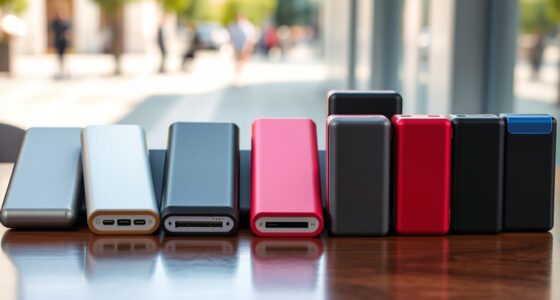If you’re looking for the best handheld GPS units in 2025, I recommend models that combine rugged durability, clear sunlight-readable screens, and multi-band satellite support for maximum accuracy. Devices like the Garmin GPSMAP 65, eTrex series, and Rino 700 stand out for their toughness and features tailored to outdoor explorers and surveyors. Each offers long battery life, reliable connectivity, and precise positioning. Stay with me, and I’ll share more insights on choosing the perfect navigational companion.
Key Takeaways
- The top GPS units feature rugged, waterproof designs suitable for tough outdoor conditions and demanding environments.
- They have sunlight-readable, high-contrast displays for clear visibility in bright outdoor settings.
- Multi-system satellite support ensures precise positioning even in challenging terrains.
- Long battery life and versatile power options enable extended use in remote locations.
- Additional features like mapping, waypoint navigation, and communication tools cater to various outdoor and professional needs.
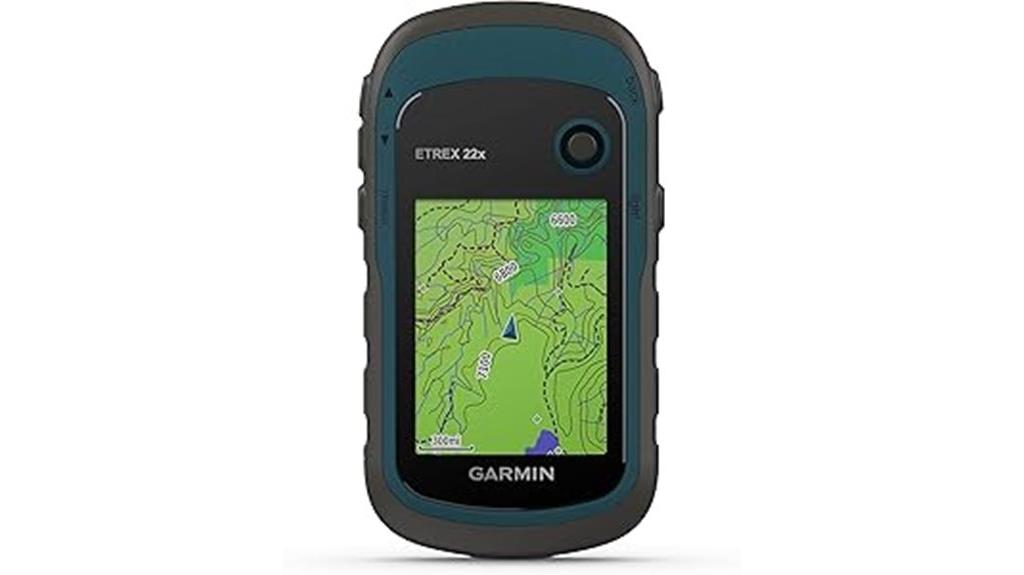
The Garmin eTrex 22x stands out as an excellent choice for outdoor enthusiasts who need a rugged, reliable GPS device that can handle tough conditions. Its compact design and IPX7 waterproof rating make it perfect for hiking, cycling, or land surveying. With a sunlight-readable color display, I can easily see my maps even in bright sunlight. The device supports GPS and GLONASS, ensuring accurate tracking in challenging environments. Its long-lasting battery life of up to 25 hours and expandable memory via microSD make it dependable on extended adventures. While its interface feels a bit dated, its durability and core features make it a trusted companion in the outdoors.
Best For: outdoor enthusiasts, hikers, and professionals who need a durable, reliable GPS device with long battery life and rugged design.
Pros:
- Rugged construction with IPX7 waterproof rating, suitable for tough outdoor conditions
- Long battery life of up to 25 hours using 2 AA batteries
- Supports GPS and GLONASS for accurate tracking in challenging environments
Cons:
- Outdated interface and small screen can be difficult to read in bright sunlight
- Limited modern connectivity options like Wi-Fi or Bluetooth for updates and data sync
- Map loading and navigation features may have a steep learning curve and can be time-consuming
Garmin eTrex® SE GPS Handheld Navigator
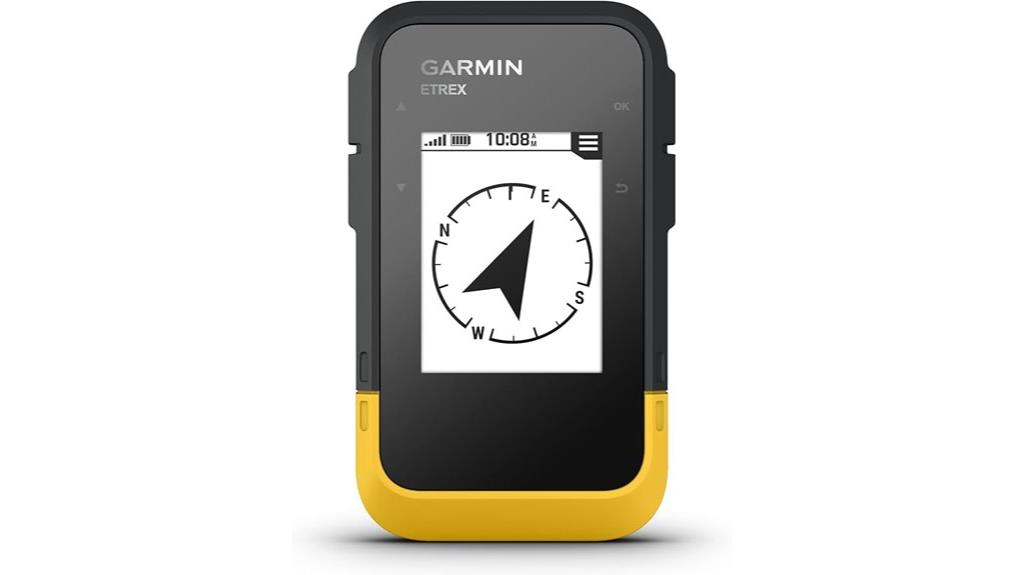
For outdoor enthusiasts seeking a reliable handheld GPS, the Garmin eTrex® SE stands out with its impressive 2.2-inch sunlight-readable display designed for easy visibility in bright conditions. Its compact size, measuring just 4.8 x 5.24 x 2.13 inches and weighing only 5.5 ounces, makes it highly portable. The device is water-resistant (IPX7 rated), perfect for all weather scenarios. With support for multiple satellite systems—GPS, GLONASS, Galileo, BeiDou, and QZSS—it offers accurate tracking even in challenging environments. Long-lasting battery life, up to 168 hours in standard mode, guarantees dependable navigation during extended adventures. Connectivity via Bluetooth and USB adds convenience.
Best For: outdoor enthusiasts and adventurers seeking a durable, feature-rich handheld GPS for reliable navigation in challenging environments.
Pros:
- Supports multiple satellite systems (GPS, GLONASS, Galileo, BeiDou, QZSS) for accurate positioning in difficult conditions
- Long battery life up to 168 hours in standard mode, ideal for extended trips
- Compact, lightweight design with sunlight-readable display for easy outdoor visibility
Cons:
- Requires 2 AA batteries (not included), which may need frequent replacement during long outings
- Limited screen size at 2.2 inches may restrict detailed map viewing for some users
- Lacks built-in maps; requires external map loading via compatible software or apps
Garmin inReach Mini 2 Satellite Communicator
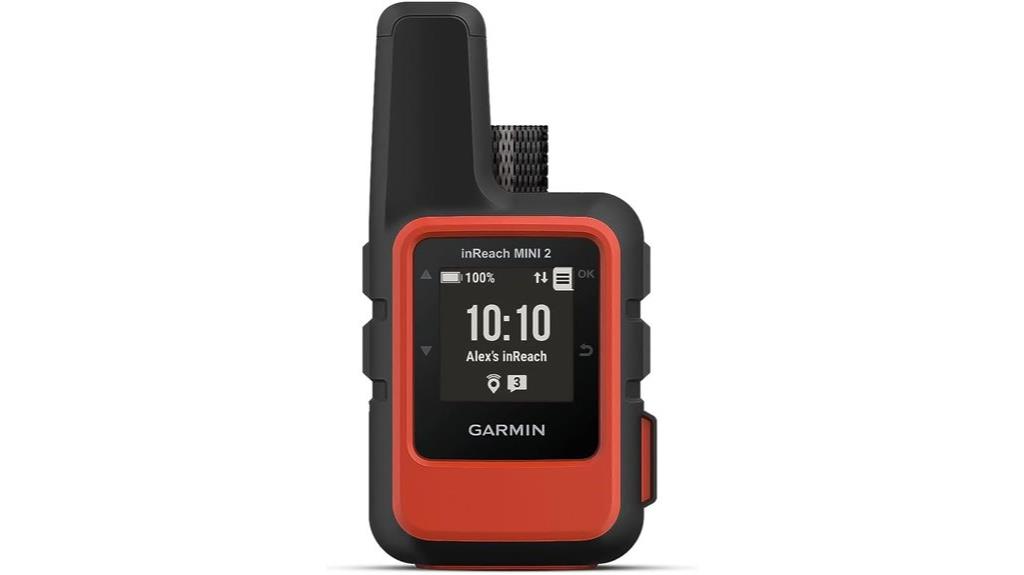
If you’re an outdoor enthusiast who needs reliable global connectivity, the Garmin inReach Mini 2 Satellite Communicator is an excellent choice. Its compact, lightweight design makes it easy to carry on any adventure. It offers two-way messaging, interactive SOS, and global coverage (with an active satellite subscription). Features like Bluetooth, water resistance, and a digital compass assure durability and accurate navigation, even when stationary. The device syncs seamlessly with the Garmin Explore app for trip planning, maps, and waypoints. With up to 14 days of battery life, it’s perfect for extended trips. Highly rated and versatile, the inReach Mini 2 keeps you connected when it matters most.
Best For: outdoor enthusiasts and adventurers who require reliable global satellite connectivity for navigation and communication during remote explorations.
Pros:
- Compact, lightweight design ideal for portability during outdoor activities
- Up to 14 days of battery life supports extended trips without recharging
- Seamless integration with Garmin Explore app for detailed trip planning and mapping
Cons:
- Requires an active satellite subscription for full functionality
- Discontinued model may have limited support or accessories availability
- Limited display size with 176 x 176 resolution, which may affect ease of use in bright conditions
Garmin GPSMAP 65 Handheld GPS Navigator
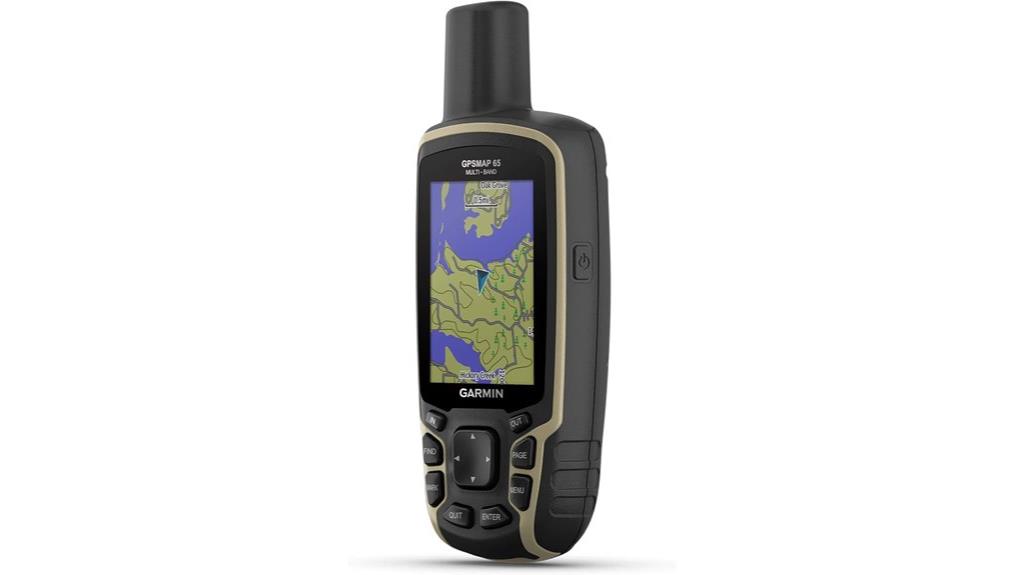
Designed for rugged outdoor adventures, the Garmin GPSMAP 65 stands out with its multi-band GNSS support and high-precision accuracy, making it an ideal choice for serious hikers, hunters, and explorers. Its large 2.6-inch sunlight-readable color display, weather-resistant build, and dedicated buttons ensure reliable operation even in tough conditions. Supporting GPS, GLONASS, Galileo, and QZSS, it offers about 6-foot accuracy in challenging environments. With preloaded TopoActive and federal land maps, plus wireless connectivity for managing routes and waypoints, this device combines durability, precision, and user-friendly features, making it a dependable companion for outdoor navigation in 2025.
Best For: serious outdoor enthusiasts, such as hikers, hunters, and explorers, seeking a rugged, accurate GPS device for challenging environments.
Pros:
- High-precision multi-band GNSS support providing about 6-foot accuracy in tough terrains
- Durable, weather-resistant build with large sunlight-readable color display for outdoor visibility
- Wireless connectivity options for easy management of routes, waypoints, and map updates
Cons:
- Complex software ecosystem with outdated apps like BaseCamp and Garmin Express can be cumbersome to navigate
- Loading and managing custom maps may require effort and technical familiarity
- Some regional map coverage limitations, requiring additional map purchases for full coverage
Garmin eTrex 32x, Rugged Handheld GPS Navigator
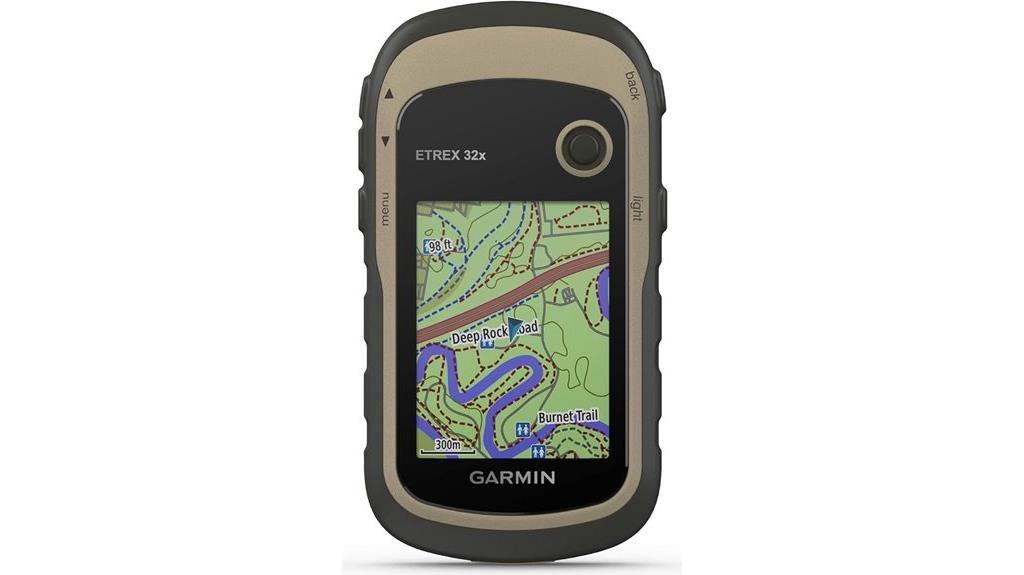
The Garmin eTrex 32x stands out as an ideal choice for outdoor enthusiasts who need a rugged, reliable GPS in challenging environments. Its 2.2-inch sunlight-readable color display makes navigation easy in bright conditions. Preloaded with Topo Active maps and supporting both GPS and GLONASS satellites, it’s perfect for remote trails and tough terrains. The device includes a 3-axis compass, barometric altimeter, and up to 25 hours of battery life with AA batteries. Compact and durable at just 5 ounces, it’s easy to operate with a cursor stick instead of a touchscreen. Overall, it’s a dependable, budget-friendly option for outdoor explorers seeking accurate, durable navigation.
Best For: outdoor enthusiasts seeking a rugged, reliable GPS device for hiking, camping, and remote adventures on a budget.
Pros:
- Durable and lightweight design weighing only 5 ounces, suitable for backpacking and outdoor use
- Supports both GPS and GLONASS satellites for accurate tracking in challenging terrains
- Long battery life of up to 25 hours with 2 AA batteries, ideal for extended trips
Cons:
- No touchscreen, which can be inconvenient in cold weather or when wearing gloves
- Outdated USB connection requiring a mini USB port, limiting compatibility with modern devices
- Software updates can be time-consuming and may cause map glitches or performance issues
ZL180 Handheld GPS for Surveying
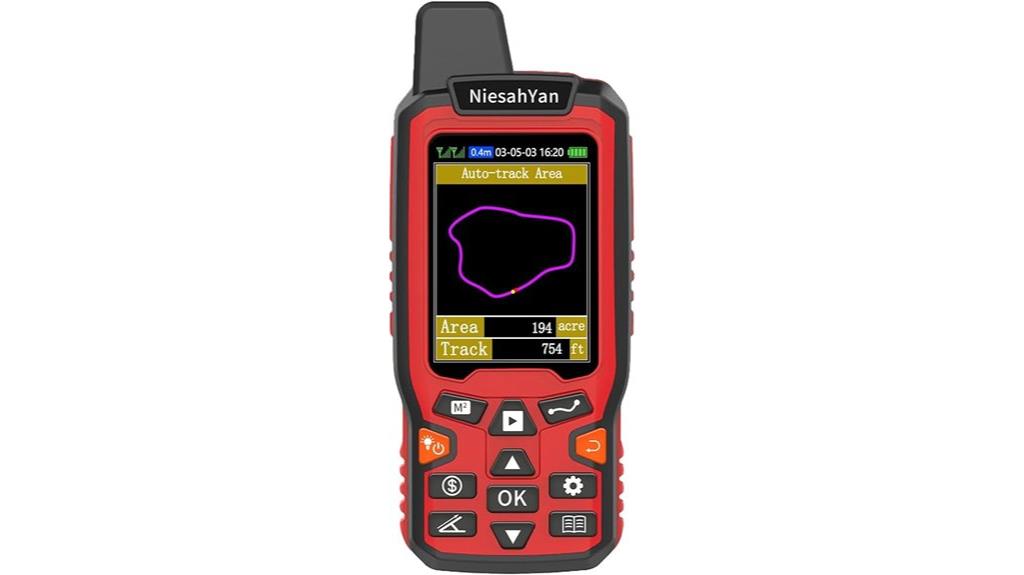
For land surveyors and outdoor enthusiasts seeking a reliable, high-precision device, the ZL180 Handheld GPS for Surveying stands out with its support for both GPS and GLONASS satellites, ensuring fast and accurate positioning even in challenging environments. Its rugged design and compact size make it easy to carry and handle in outdoor settings. It offers high accuracy, supporting 2 high-sensitivity satellites for reliable coverage, with area measurement errors around 0.003 acres. Ideal for plotting land, measuring lawns, or old site pinpointing, it displays results directly on a clear LCD screen. However, it doesn’t save waypoints or navigation data, limiting its use to land surveying tasks.
Best For: land surveyors and outdoor enthusiasts needing a durable, high-precision GPS device for plotting land and measuring areas in open outdoor environments.
Pros:
- Supports both GPS and GLONASS satellites for reliable, fast positioning in various outdoor conditions
- Compact, lightweight design with rugged construction and ergonomic grip for easy handling
- High accuracy with minimal area measurement error around 0.003 acres and clear LCD display
Cons:
- Cannot save waypoints or navigation data, limiting its use to land measurement only
- Accuracy issues reported in longitude, latitude, and altitude readings by some users
- Limited data format customization, making it difficult to match other mapping or GIS systems
Garmin GPSMAP 67i Rugged GPS Handheld with Satellite Technology
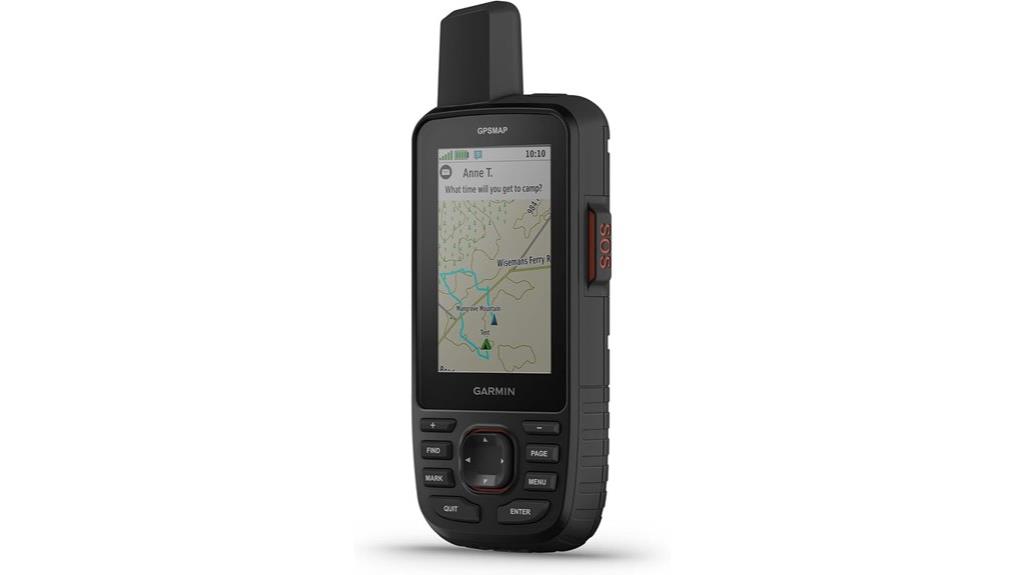
If you need a rugged handheld GPS with reliable satellite communication, the Garmin GPSMAP 67i stands out as an excellent choice. Its large 3-inch sunlight-readable color display makes it easy to see in any lighting. With two-way messaging and real-time location tracking via the Iridium satellite network, you’re always connected, and you can trigger an SOS to Garmin Response℠ if needed. It comes preloaded with TopoActive maps, satellite imagery, and supports multi-band GNSS for accurate navigation. The device pairs with your smartphone for weather updates and Geocaching features. Its long-lasting battery—up to 165 hours—ensures dependable power for extended adventures.
Best For: outdoor enthusiasts, adventurers, and professionals who need reliable GPS navigation and satellite communication in rugged environments.
Pros:
- Large, sunlight-readable 3-inch color display for easy viewing in all lighting conditions
- Global Iridium satellite network enables two-way messaging, real-time tracking, and emergency SOS capabilities
- Preloaded TopoActive maps, satellite imagery, and multi-band GNSS support for precise navigation
Cons:
- Subscription required for Garmin Response℠ emergency services and some premium mapping features
- Heavier and bulkier compared to standard handheld GPS devices, which may affect portability
- Limited to 165 hours of battery life in typical tracking mode, which might be insufficient for very long expeditions
A8 Handheld GPS for Hiking with Waterproof Design and Extra Battery
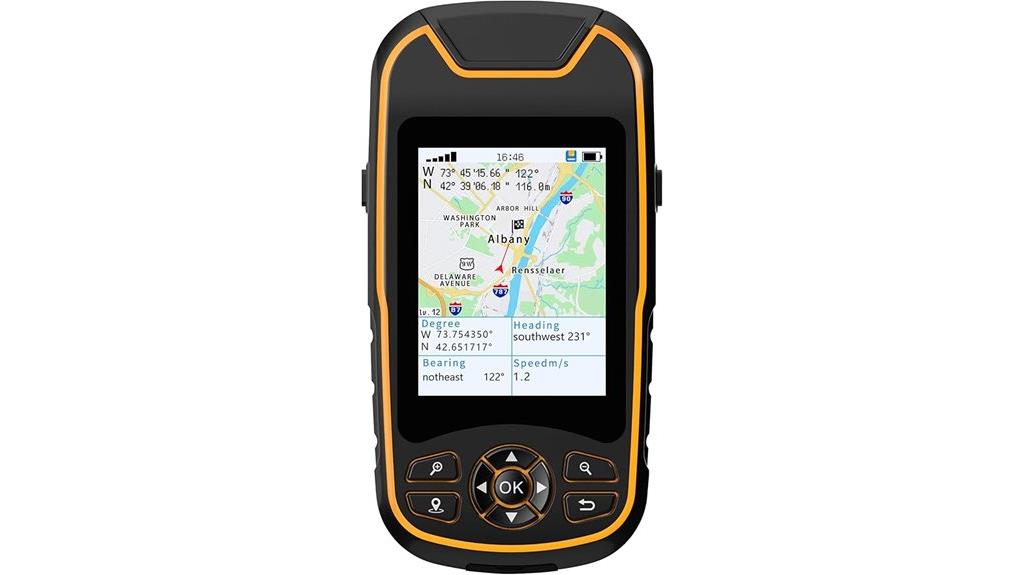
When tackling challenging outdoor conditions, having a rugged GPS with a waterproof design and long-lasting battery can make all the difference. The A8 Handheld GPS is built for durability, with an IP66 waterproof rating and a lightweight 7.4-ounce frame. It supports multiple satellite systems (GPS, GALILEO, BEIDOU, QZSS), ensuring accurate tracking within 5 feet even in tough environments. Its 4000mAh rechargeable battery delivers up to 24 hours of continuous use. The device features a sunlight-readable 3.2-inch display, 16GB storage, and includes essential tools like a barometer. While mapping and software can be tricky, the A8’s ruggedness and battery life make it ideal for serious hikers.
Best For: serious outdoor enthusiasts and professionals who need a rugged, waterproof GPS with long battery life and multi-GNSS support for challenging environments.
Pros:
- Supports multiple satellite systems (GPS, GALILEO, BEIDOU, QZSS) for improved accuracy and reliability
- Rugged, waterproof IP66 design suitable for harsh outdoor conditions
- Long-lasting 24-hour battery life with a durable 4000mAh rechargeable battery
Cons:
- Complex map downloading and limited map detail outside the US can be frustrating
- Non-touch tactile interface may be less intuitive for some users
- Slow initial satellite lock and limited zoom levels can hinder detailed navigation
Garmin eTrex Solar GPS Handheld Navigator

The Garmin eTrex Solar GPS Handheld Navigator stands out for outdoor enthusiasts who need reliable, long-lasting navigation without relying heavily on detailed maps. Its 2.2-inch high-contrast display remains clear even in bright sunlight, and its IPX7 water resistance guarantees durability in tough conditions. The device’s multi-band GPS technology provides accurate positioning within 6-8 feet, while the digital compass works reliably even when stationary. With solar charging, it can operate almost indefinitely in sunlight, and the Bluetooth connectivity enables seamless integration with smartphones and Garmin Explore. Though it lacks detailed maps, its rugged build and impressive battery life make it a solid choice for outdoor adventures.
Best For: outdoor enthusiasts and hikers seeking a durable, long-lasting GPS device with reliable accuracy and solar charging capabilities, without the need for detailed maps.
Pros:
- Excellent battery life with solar charging, enabling extended use in sunlight
- High-contrast display readable in bright sunlight and water-resistant IPX7 rating for durability
- Multi-band GPS provides precise positioning within 6-8 feet and a reliable digital compass
Cons:
- Lacks preloaded detailed maps, limiting navigation options to basic route and waypoint tracking
- Small, black-and-white display can be limiting for detailed map viewing and navigation
- Occasional satellite signal loss and complex software updates may frustrate some users
Garmin GPS 73, 2.6 inches, Model:010-01504-00
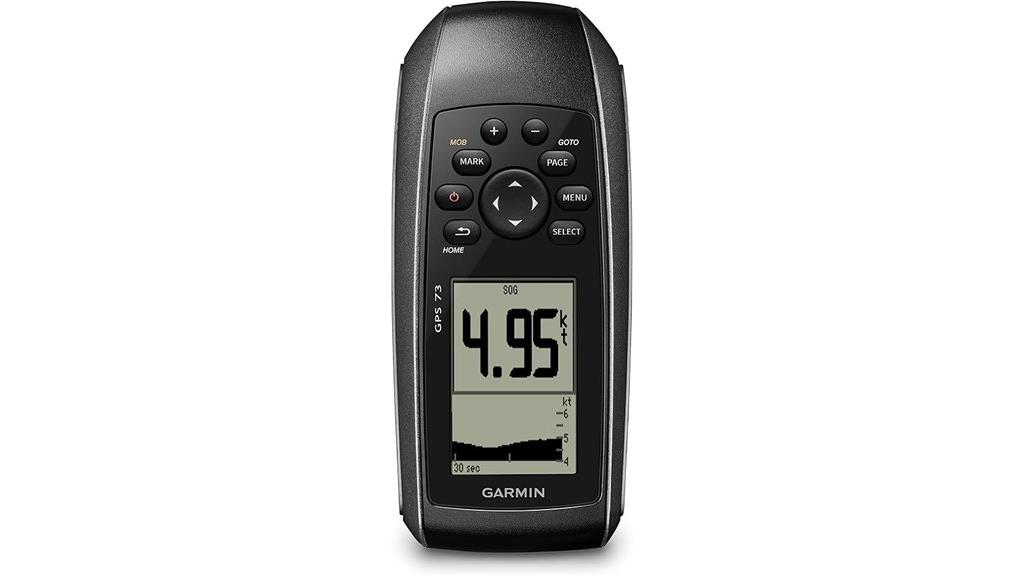
The Garmin GPS 73 stands out for its compact 2.6-inch display combined with advanced marine navigation features, making it ideal for sailors and outdoor enthusiasts alike. It includes SailAssist with virtual starting lines, countdown timers, tack assist, and speed history, along with marine alarms like off course and anchor drag alerts. The device also offers a Man Overboard function, route planning, and reliable navigation tools. Powered by 2 AA batteries, it lasts over 18 hours, perfect for long trips. Its intuitive interface and backlit buttons make operation straightforward, and it stores up to 1,000 waypoints and 100 tracks, ensuring quick access to essential info.
Best For: sailors and outdoor enthusiasts seeking a compact, feature-rich marine GPS device with long battery life and easy-to-use navigation tools.
Pros:
- Compact 2.6-inch display ideal for handheld use on boats or in the outdoors
- Includes advanced marine features like SailAssist, MOB, route planning, and alarms for safety and navigation
- Long-lasting battery life of over 18 hours with 2 AA batteries
Cons:
- Limited screen size may be less suitable for detailed mapping or large displays
- Uses AA batteries, which may require carrying spare batteries for extended trips
- Storage capacity of 1,000 waypoints and 100 tracks might be limited for very extensive navigation needs
Garmin eTrex SE GPS Handheld Navigator (Renewed)
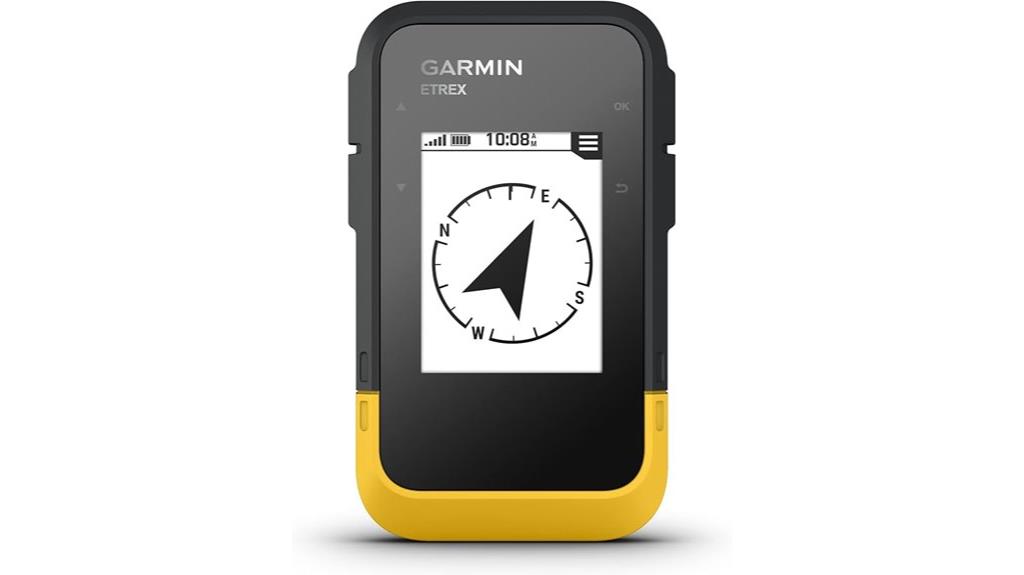
If you’re seeking a reliable handheld GPS that combines affordability with solid performance, the Garmin eTrex SE GPS Handheld Navigator (Renewed) is an excellent choice. Its 2.6-inch display is clear and easy to read in various conditions, and it’s built tough to handle rugged environments. The device offers impressive battery life, with multiple power options to extend usage during long adventures. It supports various satellite systems like GPS, GLONASS, and Galileo for accurate navigation. Plus, it features weather resistance and basic app connectivity, making it a dependable tool for outdoor explorers who need durability and reliable GPS performance without breaking the bank.
Best For: outdoor enthusiasts and adventurers seeking an affordable, durable, and reliable handheld GPS for rugged environments.
Pros:
- Clear 2.6-inch display that’s easy to read in various conditions
- Supports multiple satellite systems including GPS, GLONASS, and Galileo for accurate navigation
- Long battery life with multiple power options suitable for extended outdoor activities
Cons:
- Basic app connectivity with limited smart features
- Not equipped with advanced mapping or touchscreen capabilities
- Might lack some premium features found in higher-end GPS devices
Garmin GPSMAP 79s Marine GPS Handheld
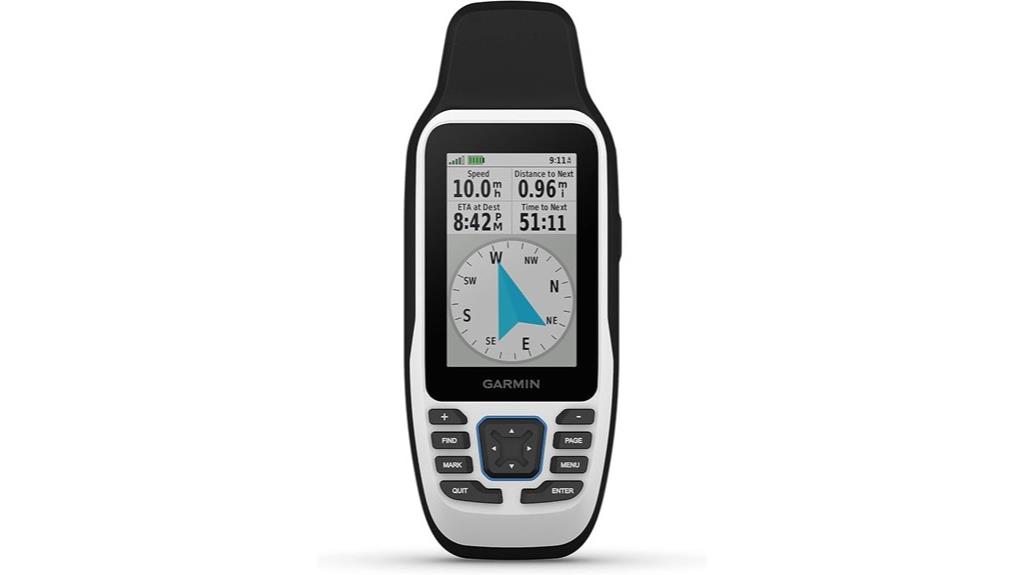
For marine enthusiasts and outdoor adventurers who need a reliable, rugged device, the Garmin GPSMAP 79s stands out with its floating design and water resistance, making it perfect for boating and water-based activities. Its high-resolution, sunlight-readable color display remains clear in bright conditions, while its IPX6 rating guarantees water resistance. Built to endure tough environments, it’s fogproof, scratch-resistant, and equipped with a 3-axis compass and barometric altimeter for precise navigation. With support for multiple satellite systems, it offers dependable worldwide tracking. Plus, its large memory capacity allows you to store thousands of waypoints and routes, making it a versatile companion on any marine adventure.
Best For: marine enthusiasts and outdoor adventurers seeking a durable, water-resistant GPS device with reliable navigation features for boating and water-based activities.
Pros:
- Rugged, floating design ideal for marine environments
- Supports multiple satellite systems for dependable worldwide tracking
- Large memory capacity stores thousands of waypoints, routes, and activities
Cons:
- Slightly heavy at 9.9 ounces, which may impact portability for some users
- Higher price point compared to basic GPS units with fewer features
- Limited to handheld use, which may require additional mounting accessories for convenience
Garmin Drive™ 53 GPS Navigator
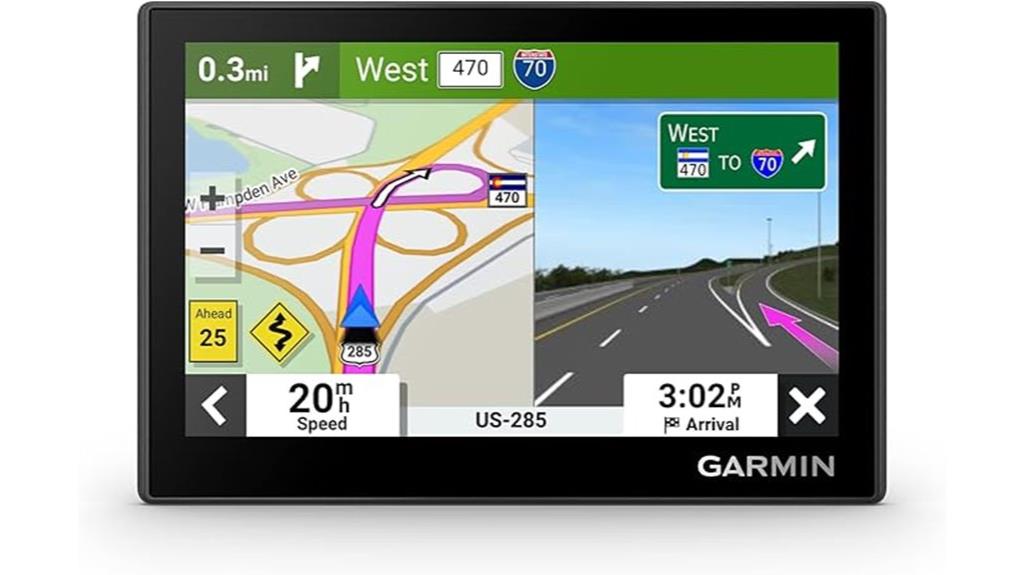
Designed for drivers who value simplicity and reliable navigation, the Garmin Drive™ 53 GPS Navigator features a bright 5-inch high-resolution touchscreen that delivers clear, easy-to-read directions. Its sleek, compact design fits comfortably in your vehicle without obstructing your view. With detailed North American maps and Garmin Real Directions, it guides you accurately using landmarks and clear voice prompts. The device offers driver alerts for hazards, speed changes, and school zones, enhancing safety. It also helps with trip planning by showing fuel stops, restaurants, and attractions. Overall, it’s a straightforward, dependable choice for everyday driving and road trips.
Best For: drivers seeking a simple, reliable GPS device with clear directions and basic trip planning features without the need for smartphone integration.
Pros:
- Easy-to-use touchscreen interface with quick setup and updates
- Accurate turn-by-turn directions with landmark guidance
- Compact, sleek design that fits comfortably in vehicles without obstructing view
Cons:
- Limited battery life, requiring constant power connection during use
- Occasional inaccuracies in address searches or location updates
- Basic feature set without advanced connectivity or smart features
A6 Handheld GPS for Hiking

The A6 Handheld GPS stands out as an excellent choice for hikers who prioritize accuracy and durability in challenging outdoor conditions. Its multi-GNSS support ensures precise positioning with less than 5 feet of error, even in tough terrains. The rugged, waterproof design (IP65) and non-slip buttons make it reliable in rain or mud. With a bright 2.4-inch sunlight-readable display, orienting oneself is straightforward. It offers extensive waypoint storage, track recording, and back-to-start guidance, all powered by a long-lasting 20-hour battery. While it doesn’t include maps, its robust build and precise navigation make it a top contender for serious hikers seeking durability and accuracy.
Best For: hikers and outdoor enthusiasts seeking a durable, highly accurate GPS device for challenging terrains without the need for preloaded maps.
Pros:
- Supports multiple satellite systems (GPS, GLONASS, BEIDOU, QZSS) for superior positioning accuracy <5ft
- Rugged, waterproof (IP65) construction with non-slip buttons ideal for tough outdoor conditions
- Long-lasting 20-hour battery life suitable for extended hikes and outdoor adventures
Cons:
- Does not include built-in maps, requiring users to plan routes beforehand or use external map sources
- Customer ratings average only 3.0 out of 5 stars, indicating mixed user feedback
- Limited to 1000 stored waypoints, which may be restrictive for extensive trip planning

If you need a GPS unit that combines reliable navigation with robust communication, the Garmin Rino 700 Rugged 2-Way Radio & GPS Navigator stands out. It features a powerful 5W GMRS radio with up to 20 miles of range, voice communication, and text messaging between units. The high-sensitivity GPS and GLONASS receivers guarantee accurate tracking even in tough environments, while the worldwide base map helps with basic navigation. Its rugged design, long-lasting lithium-ion battery, and easy thumbstick control make it perfect for outdoor adventures. Plus, Bluetooth connectivity adds extra control options, making it a versatile tool for explorers and professionals alike.
Best For: outdoor enthusiasts, search and rescue teams, and professionals needing reliable communication and navigation in rugged environments.
Pros:
- Powerful 5W GMRS radio with up to 20 miles range for extended communication
- Reliable GPS and GLONASS satellite reception for accurate tracking in tough conditions
- Rugged design and long-lasting battery suitable for outdoor activities
Cons:
- Limited to basic navigation features with worldwide base map, lacking advanced mapping options
- May be heavier or bulkier compared to smaller handheld devices
- Requires licensing for GMRS radio use in some regions
Factors to Consider When Choosing Handheld GPS Units
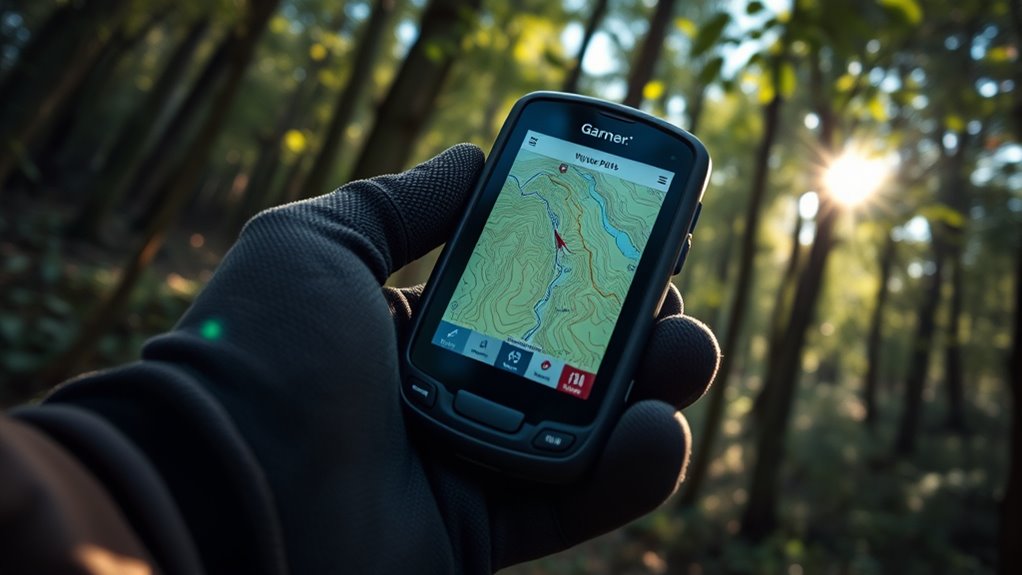
When choosing a handheld GPS, I consider factors like battery life and durability to guarantee it lasts through my adventures. Screen readability in various conditions and satellite system support are also vital for accurate navigation. Additionally, I look at storage capacity and connectivity options to keep my maps and data accessible at all times.
Battery Life Durability
Long-lasting battery life is vital for handheld GPS units, especially during extended outdoor adventures. Some models offer up to 25 hours or more on standard batteries, ensuring you won’t run out of power when it matters most. Rugged units built to withstand water, dust, and shocks are essential for tough environments, providing durability and peace of mind. The option of replaceable batteries, like AA batteries, allows quick swaps for continuous use without needing recharging or specialized power sources. Solar charging capabilities can also extend operational time greatly in sunny conditions, nearly providing unlimited power in ideal environments. Features like waterproof ratings (IPX7, IPX6) and tough construction materials further protect your device from damage, making sure your GPS stays reliable no matter the challenge.
Screen Readability Conditions
A clear, easy-to-read display can make a big difference during outdoor navigation, especially in bright sunlight or low-light conditions. A high-contrast, sunlight-readable screen reduces glare and reflections, ensuring you can see your maps clearly without straining your eyes. Screen size also matters; larger screens with high resolution make it easier to view detailed maps and data at a glance. The display technology, such as transflective or OLED, determines how well the screen performs in various lighting environments, from direct sunlight to dusk. Durability features like waterproofing and rugged construction protect the screen from water, dust, and impacts, maintaining visibility over time. Additionally, adjustable brightness and anti-glare coatings enhance usability, so you can adapt the display to any lighting condition for ideal clarity.
Satellite System Support
Supporting multiple satellite systems like GPS, GLONASS, Galileo, and BeiDou is essential for reliable positioning, especially in challenging environments. Devices that utilize multi-GNSS support can acquire satellite signals faster and maintain better lock in dense forests, urban canyons, and remote areas. This multi-constellation capability improves accuracy and reduces signal dropout, ensuring you stay on course. Additionally, multi-band technology enhances resistance to interference and multipath errors, which often disrupt signals in tricky terrains. Some units even support real-time tracking across multiple satellite networks simultaneously, providing more consistent coverage and faster updates. Being able to switch seamlessly between systems guarantees continuous operation when one network faces outages or limited coverage, making these units more dependable for serious navigators in diverse conditions.
Map and Data Storage
When selecting a handheld GPS unit, considering its map and data storage capabilities is key to ensuring it meets your navigation needs. Storage capacity varies widely, from just a few megabytes to several gigabytes, influencing how many maps, waypoints, and tracks you can store. Many devices support microSD or SD card slots, allowing you to expand storage for additional data. Preloaded maps differ in detail and coverage; some offer extensive topographical or street maps, while others provide basic basemaps. Your ability to download, update, and customize maps depends on compatibility with mapping software and data formats. Effective data management features—such as exporting, importing, and sharing waypoints and routes—are also vital for integrating your GPS data into larger navigation workflows, especially for advanced users.
Connectivity Options Available
Choosing the right connectivity options for a handheld GPS is essential because they directly impact how you transfer data, update maps, and stay connected in the field. Bluetooth lets you pair with smartphones and accessories for quick data sharing, notifications, and map updates. USB ports are reliable for software updates, transferring waypoints, and downloading maps directly to your device. Wi-Fi capability offers wireless map and software updates, plus potential for live tracking or sharing your location with others. Some advanced models support satellite-based communication or two-way messaging, which can be lifesavers in remote areas. However, many basic units lack external connectivity options altogether. Your choice depends on your needs—whether you prioritize seamless updates, real-time communication, or simplicity without external connections.
Ease of Operation
A handheld GPS is only as useful as it is easy to operate, especially in demanding outdoor conditions. I look for devices with straightforward interfaces, such as tactile buttons or simple touchscreens, that make navigation seamless even when my hands are gloved or wet. Intuitive menus, clear icons, and minimal steps for common tasks help me avoid errors and save time. A large, high-contrast display is essential for quick map reading in bright sunlight, reducing eye strain. Physical controls like toggle sticks or rotary dials offer reliable usability without relying solely on touch, which is vital outdoors. Additionally, comprehensive manuals and tutorials ensure I can quickly learn features and maximize the device’s potential, making navigation safer and more efficient in challenging environments.
Price and Value
Price and value are essential factors when selecting a handheld GPS unit, as they directly impact how well the device meets my needs without overspending. GPS units range from about $50 for basic models to over $500 for advanced, rugged devices. Higher-priced units usually offer better durability, more accurate multi-GNSS support, larger or higher-resolution screens, and expanded mapping features, providing better long-term value. Cheaper models might lack critical features like detailed maps, waterproofing, or long battery life, which can limit their usefulness. To find the best balance, I evaluate the features, build quality, and accuracy relative to cost. Sometimes, investing a bit more upfront in a reliable, durable unit saves money over time by reducing repairs or upgrades.
Frequently Asked Questions
How Do Battery Life and Power Options Vary Across Different GPS Models?
Battery life and power options vary widely among GPS models. Some offer impressive endurance, lasting days on a single charge, while others need frequent recharging. Many models have replaceable batteries, allowing for extended use, and some include solar charging features for outdoor adventures. I recommend checking each device’s specifications to see if the power options match your needs, especially for long trips where reliable power is essential.
What Environmental Conditions Can Each GPS Withstand Effectively?
Each GPS unit I’ve used is built to withstand specific environmental conditions. Many are waterproof or water-resistant, handling rain and splashes well. Rugged models tolerate drops, shocks, and dust, making them perfect for harsh terrains. Some are designed for extreme cold or heat, ensuring functionality in snow or desert conditions. Always check the IP rating and durability features to match your environment, so your device stays reliable no matter where you go.
Are There Any Subscription or Service Fees Associated With These GPS Units?
Using a GPS is like having a trusty compass in your pocket, and I can tell you, most of these units don’t charge extra fees. They typically come with built-in maps and features included in the purchase price. Some advanced models might offer optional subscription services for real-time updates or detailed mapping, but you don’t need to pay for basic navigation. I recommend checking each device’s specifics before buying.
How User-Friendly Are the Interfaces for Beginners Versus Experienced Navigators?
I find that most GPS units are quite user-friendly for beginners, with simple interfaces and clear menus. Experienced navigators will appreciate advanced features and customization options. I recommend starting with a model that offers intuitive navigation and helpful tutorials; that way, you’ll quickly get comfortable. Over time, you can explore more complex functions as your skills grow. Overall, these devices are designed to accommodate all experience levels seamlessly.
What Additional Features, Like Altimeters or Barometers, Do Some Units Include?
Did you know that over 60% of advanced GPS units include sensors like altimeters and barometers? I find these features incredibly useful—altimeters help measure elevation changes, essential for mountain hikes, while barometers predict weather shifts. Many units also include compass functions and temperature sensors, making them versatile for outdoor adventures. These extras boost navigation accuracy and safety, especially in challenging environments where every detail counts.
Conclusion
Choosing the right handheld GPS can feel like finding a trusted companion on your adventures. With options that blend durability, accuracy, and ease of use, you’ll likely discover a device that gently guides you through every journey. Remember, it’s not just about the tech but how it seamlessly fits into your outdoor story. So, take your time, explore your options, and let your next adventure unfold with confidence and clarity.
